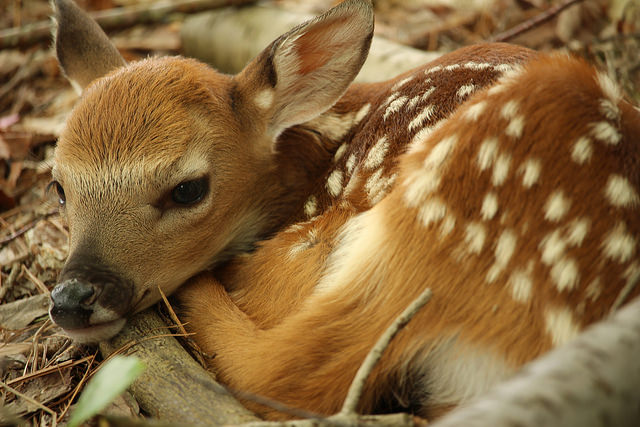This is the time of year for everything – farming, gardening, mowing, planting, harvesting, equipment repairs, house projects, building projects, the list goes on and on. There is so much happening that it is hard to remember to simply take a break and enjoy the world. However, taking that time is just as important as the to-do list because there are a lot of other things happening. New babies are appearing in the world, birds are nesting, summer moths are flying about and laying eggs, fawns are taking their first tentative steps, hatching frog eggs fill ponds with tadpoles, and that list goes on and on.
In the morning, eating breakfast, I confess to watching a cartoon. Yes, usually by myself, no children involved. On my PBS station at 6:00 and 6:30 a.m. Wild Kratts comes on. If you’ve never seen this show, it is hard to explain. It is hosted by the Kratt brothers, Chris and Martin, and they morph from their real human selves into cartoon characters that go on creature adventures. Trust me, look it up and watch an episode. It is great.

Red-winged Blackbirds typically nest low among marsh vegetation, shrubs, or trees. The nest is made by weaving wet plant materials, adding mud for structure, and finally lined with fine, dry grasses.
The information presented is almost always accurate, though with the expected cartoon “unlikelies” such as a miniaturizer, creature power vests, and a flying turtle-shaped ship called the Tortuga. As the stress and pressure of the spring and summer to-do lists gets heavier, we make time for, as we now call them, creature adventures.
Going on a creature adventure is easy – no creature powers required. Usually just boots, binoculars, and a camera. Discoveries range from progress in the vernal pool to Red-winged Blackbird nest and eggs in the raspberry patch. Creature adventures are the hour when we slow down to remember that the world is big and our list is small in the scheme of things.
At Audubon the naturalists also make it a point to go outside, hopefully daily, for their own restorative creature adventures. Sometimes it is with a group of school kids, other times with fellow naturalists, still other in solitude. On a walk this week, a group passed a brand-new Luna Moth on the path, and the last child in the entire group was the one to spot it. That discovery turned to fascination, the walk agenda went out the window and we huddled around this beautiful creature. We also “rescued” it and placed it on a tree, out of the wind and away from the dangerous foot traffic on the trails.
Creature adventures happen in your backyard, a city street, or the forest. They happen anywhere you want them, anywhere you need them. With the amount of change happening at Audubon (in case you haven’t heard, our long-time President, Ruth Lundin, retired) these nature breaks are absolutely needed. I feel like close encounters with caterpillars are what is truly keeping us sane at times.

Saving snails from sidewalks.
In the cartoon, rescuing animals is often a part of the show, promoting empathy among its watchers and hopefully planting the seed for an eco-ethic. On the same day as the Luna Moth, the kindergarten group would have been perfectly content to rescue snails from the hot pavement the entire time. Each snail was important to them, each an individual, each a discovery. From an adult point of view, it is easy to dismiss the life of one snail (there are millions, after all). In stopping to think about what put them in danger, though, it is one hundred percent human created.
Large expanses of radiating, hot pavement don’t naturally exists. Large rocks do, but rarely do large rocks form a virtually impenetrable barrier to the movement of a slime-footed creature. In watching this show in the morning, I am sometimes torn by the “rescues” as there are tragedies and naturally occurring death in the natural world. They do a good job, though, showing predators catching and consuming prey, and there is a good episode on that topic where they share how hard it is for human to understand.
Taking creature adventures gets you closer to it all. The drama, the resilience, the sadness and the triumphs of the natural world. The magic of a bird nest cradling eggs shows how nature nurtures its young. A squishy mass of frog eggs is a different strategy, flooding the world with enough young that some may escape predation. The pile of feathers is a reminder that hunters need animals, too, to sustain them and their young. Watching a mother squirrel move her babies deeper into the woods teaches us that sometimes we can’t understand the why, but to appreciate the wonder with which the world works.
Take a moment each day and go on a creature adventure. Even if it just to the spider’s web in the bushes by the front porch. Watch, wonder, learn, treasure. That is the true reward of creature adventuring.
Sarah Hatfield is a naturalist at Audubon Community Nature Center.
Audubon Community Nature Center builds and nurtures connections between people and nature. ACNC is located just east of Route 62 between Warren and Jamestown. The trails are open from dawn to dusk as is Liberty, the Bald Eagle. The Nature Center is open from 10 a.m. until 4:30 p.m. daily except Sunday when it opens at 1 p.m. More information can be found online at auduboncnc.org or by calling (716) 569-2345.


Recent Comments